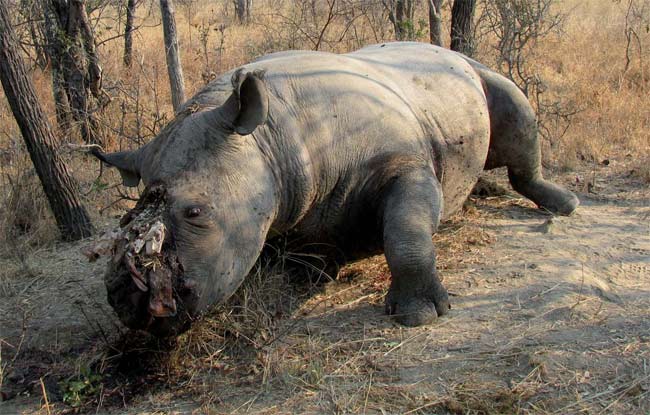Rhino Poaching: A Quiet Disaster – PC Du Toit
Out in the open grasslands lies the fallen beast, its body nestled in a basin of blood. The black rhinoceros’ horns are no longer present; a part of the beast missing, sawed off. The rhino’s neck is mangled by the presence of a snare. The carcass is already rancid with the stench of raw pain and despair; the festering flesh is surrounded by a halo of flies. Myriad maggots invade the decomposing corpse as the vultures circle the skies above the body. All this, while the helpless, vulnerable calf stands motionless next to the rotting remains of its mother. All this for a horn; all for a piece of useless agglutinated hair.
9,500 miles away in Vietnam, a 48 year old male property developer, married for 24 years with two children of 19 and 21 years old, with a mistress, living with his family in a large four-bedroom house in the capital city of Hanoi, is buying the rhino horn, ruthlessly harvested in the Kruger National Park. This is what is creating the harrowing scene above. A rhino horn (3kg) on the black market sells for a vast $246,000, fuelled by the demand in Asia, from men like this. The man described is the archetypal buyer of rhino horn, established by a survey carried out by ‘TRAFFIC’. Rhino horn is now worth more than gold and cocaine. It is believed that the trade generates $17 billion annually.
Originally rhinos were poached for medicinal purposes. However there is now a changing motivation in the rhino horn trade and it is part of the reason for the recent surge in the illicit trade. “Rhino horns are used for medicinal purposes” has almost become the stereotype for the reasons behind the poaching. But more recently the horns are not being bought for medicinal purposes, but rather for emotional benefits. A survey carried out in 2013 indicated that most were buying the horns for something even more farcical; they are buying them as status symbol. Image and status is integral to these consumers. They tend to be successful, powerful people, and often gift the horns to friends, family or colleagues to show wealth.
Since 2008, 5,940 African rhinos have been killed by poachers
Rhino poaching is a prominent problem in today’s society all over the world. It is an issue that has been debated substantially and thoroughly for many years. “What do we do?” and “How do we stop it?” are the main questions. And my main questions (among others) are: Is there an answer? And why is it happening? It is disturbing to think that our grandchildren might not even get to see a rhino. It is bizarre to think that in a few decades they could be talking about the rhino in schools in the same way as the dodo now. Extinct, gone, a distant memory, something that used to be.
South Africa is viewed as ‘the primary custodian of Africa’s rhinos, but Namibia, Zimbabwe and Kenya along with South Africa are where most of the continent’s rhinos are found. Very few are found outside of national parks and sanctuaries. Here are some statistics, just to underline how serious the situation is:
South Africa is home to 93% of white rhinos (18,796 – 2010 fig.) and 40% (1,916 – 2010 fig.) of the black rhinos in Africa. 64% of the total rhino population are found in the Kruger national Park (KNP) alone, so you won’t be surprised to hear that it is somewhat of a poaching epicentre. In 2014, 827 were poached just in the KNP. Of all the poaching related arrests, seizures and convictions from July 2015 to July 2015, 80% were in the KNP. Another harrowing statistic is that rhino poaching (overall) has increased by 9000% since 2007, and in 2014, 1,215 rhinos were poached. In the last 40 years, rhino populations have declined by 95%. Some people have said they no longer see African national parks as nature reserves, but as “killing fields”.
150 years ago, Africa’s grasslands were prolific with Rhinos; more than a million white and black rhinos roamed the savannahs. But European settlers started hunting them and the distribution started to decline: that is where this story begins.
During the 1970s and 80s there was also a significant spike in poaching. The reason? Asia thought the horn was some sort of medicinal miracle. They used it in many remedies and medicines (almost always shaved/ground into a powder and dissolved in boiling water, then consumed by the patient). They use rhino horn for a variety of reasons, ranging from the classic: “it cures cancer” to (according to ‘traditional Chinese texts’) helping with: headaches, typhoid, food poisoning, carbuncles, hallucinations, snakebites; the works. From the sounds of it, it must be some kind of wonder drug. Apparently it even works as a sexual stimulant, as well as a party drug. Incredible.
Delusional? It is strange to think that this horn, found only on a few species, is somehow thought to be the solution to all of these medical problems, as well as being an aphrodisiac. Such notions are absurd given what a rhino horn really is. What is it? Essentially it is compact hair. But if we are going to be scientific about it, then it is predominantly keratin. Keratin is a fibrous protein; it is a major component in our hair, skin and nails and in animals makes up many feathers, claws, hooves and horns. The keratin in rhino horns contains large amounts of sulphur-containing amino acids, especially cysteine. However calcium carbonate and calcium phosphate (salts) and other amino acids like tyrosine and arginine are also present. If we are to break it down to the basics, it is incredibly similar to your own hair and nails. Therefore, if you harvest your nail clippings for long enough to have a kilogram and you grind them up, you have £40,000 worth of keratin, according to black market prices for rhino horns.
Many people wonder how poachers do what they do, not only morally, but also practically. What is the lead up to the sale? How is the horn ‘collected’? There are four different ‘poacher profiles’. External poachers who go into a community/area to gather information, concerning where the rhinos are; former military personnel who, along with police and game rangers (who have specialised skills from training) develop shooting or tracking skills; wildlife industry members (since 2008), ranch owners, game rangers and wildlife vets, who have become active in the rhino poaching crisis. People are often surprised to hear that the very persons (e.g. game rangers and ranch owners) who should be in charge of conservation and stopping the crisis are often the individuals at the root of the problem, which is something that is not only surprising, but also very sad. It is a perfect example to convey just how lucrative the trade is. The final profile is “pseudo hunting”, which is poaching by non-traditional hunters, who are a major part of the illicit trade (often people who do it for subsistence, with little or no other income). Pseudo hunters often use weapons and therefore risk being discovered. Weapons like AK47 assault rifles are used, as well as cross bows and heavy calibre weapons. Axes will most likely be used by these people to remove the horn. On the other hand, veterinarians and rangers will predominantly use darting rifles. Poached rhinos are often darted using ‘M99’, a veterinary tranquiliser also known as etorphine. For series-watching fans, M99 is used by Dexter to kill his victims. It is a very powerful substance; one drop can kill a human being. These poachers dart the rhino before cutting off its horn (usually using a chainsaw) and leaving it to die. Poachers often use full moon periods when it is easier to see at night. The horn is then sold on the black market.
Now, an admirable effort has been made in terms of conservation. But the slaughter is so rife in some places that poaching has ceased. For example in Zimbabwe in 1993 about 100 rhinos were poached, and from 1994 to 1999 no rhinos were poached (or at least very, very few). Why did the figures dip? Is it really because of conservation efforts? The truth is something else heart wrenching: poaching became less prevalent purely because there were so few rhinos left to kill.
A lot has been said about the issue, but what about the solution? Conservation is viewed as the solution, that is the general consensus, and conservation is done in a variety of ways. Many charities and organisations have done similar things to WWF. WWF are doing the following things: expanding current protected areas and improving the management of these; establishing new protected areas; improving security monitoring to protect the rhinos from poaching; improving international and local legislation to stop the unlawful flow of horns in Africa to other countries and “promoting well-managed wildlife-based tourism experiences”, these will also aid the funding for other conservation projects/efforts.
The future for poaching seems bleak; it seems that poaching is an unstoppable force. The sad truth and the irony is, the fewer rhinos there are, the higher the price of horn becomes and the more tempting poaching is; it is a very lucrative business. Will we ever be able to stop this problem? If it is to work, we need a government-backed, global scheme because the market is already too developed to be tackled on a small scale by a few charities. The truth is, it is such a profitable business, even getting governments to work together is a long shot.
“Rhino horn powder does not make you look younger, make you more fertile, free you from demons, cure typhoid or the flu. It just kills rhinos.”
The rhino has only one predator, and that’s us.












Post Comment
You must be logged in to post a comment.